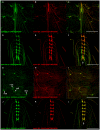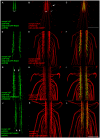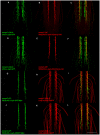A Gateway MultiSite recombination cloning toolkit
- PMID: 21931740
- PMCID: PMC3170369
- DOI: 10.1371/journal.pone.0024531
A Gateway MultiSite recombination cloning toolkit
Abstract
The generation of DNA constructs is often a rate-limiting step in conducting biological experiments. Recombination cloning of single DNA fragments using the Gateway system provided an advance over traditional restriction enzyme cloning due to increases in efficiency and reliability. Here we introduce a series of entry clones and a destination vector for use in two, three, and four fragment Gateway MultiSite recombination cloning whose advantages include increased flexibility and versatility. In contrast to Gateway single-fragment cloning approaches where variations are typically incorporated into model system-specific destination vectors, our Gateway MultiSite cloning strategy incorporates variations in easily generated entry clones that are model system-independent. In particular, we present entry clones containing insertions of GAL4, QF, UAS, QUAS, eGFP, and mCherry, among others, and demonstrate their in vivo functionality in Drosophila by using them to generate expression clones including GAL4 and QF drivers for various trp ion channel family members, UAS and QUAS excitatory and inhibitory light-gated ion channels, and QUAS red and green fluorescent synaptic vesicle markers. We thus establish a starter toolkit of modular Gateway MultiSite entry clones potentially adaptable to any model system. An inventory of entry clones and destination vectors for Gateway MultiSite cloning has also been established (www.gatewaymultisite.org).
Conflict of interest statement
Figures











References
Publication types
MeSH terms
Substances
LinkOut - more resources
Full Text Sources
Molecular Biology Databases
Research Materials

